Wahoo
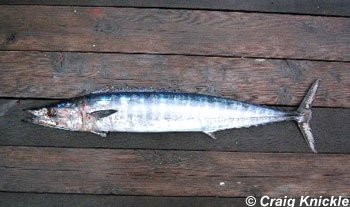
Acanthocybium solandri
This very long fish has a beak-like snout filled with tiny serrated teeth, several small fins along its dorsal ventral ridges, trailing off with a series of finlets, and then a sharply forked caudal fin. It usually grows to between 3 and 5 feet long, but has been measured at 96 inches long, and is rich blue to green on top and silver below, with striking cobalt vertical blue bars running along its body.
Popular for sport fishing and as a food catch, this solitary fish doesn’t school enough for a thriving commercial fishery.
Order – Perciformes
Family – Scombridae
Genus – Acanthocybium
Species – solandri
Common Names
Wahoo, barracuda, kingfish, malata kingfish, Pacific king-fish, and queen fish are common names in the English language. Other names include acantocibio (Italian), al (Marshallese), cavala da india (Portuguese), kamasu-sawara (Japanese), keskas (Palauan), kin fis (Creole), mersad (Palauan), ngal (Carolinian), nguru-maskati (Swahili), ono (Hawaiian), paala (Samoan), paere (French), peto (Spanish), serra-da-india (Portuguese), sierra (Spanish), and solandra (Polish) are some of the common names of this fish.
Importance to Humans
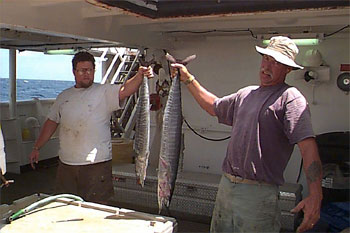
Traditionally, there have not been organized fisheries for wahoo, although it is favored for human consumption. This lack may perhaps be because wahoo do not school as many scombrids do. Wahoo is caught off South America and in the Caribbean both commercially and recreationally with longlines. In the areas where it is caught commercially, it is marketed fresh, salted, spice-cured, or frozen. The wahoo is appreciated as a gamefish, especially in the US and Australia, where it is caught by hook and line. This fish has been linked to ciguatera poisoning from human consumption of its flesh.
Conservation
This fish is not listed as endangered or vulnerable with the World Conservation Union (IUCN). The IUCN is a global union of states, governmental agencies, and non-governmental organizations in a partnership that assesses the conservation status of species.
> Check the status of the wahoo at the IUCN website.
Geographical Distribution
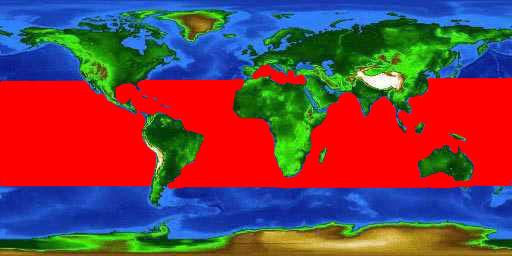
The wahoo is distributed worldwide in tropical and subtropical waters. In the Atlantic Ocean, it is found from the North American coast to approximately 40°W longitude, and from about 35°N to 38°S latitude. In the north Atlantic off the Carolinas (US) and Bermuda, the abundance of this fish is highly seasonal, being more abundant during the warmer summer months. It is distributed in the Gulf of Mexico and off the west coast of Central America. The wahoo is also present in the Mediterranean Sea and the Indian Ocean, from the east coast of Africa to the waters off Sri Lanka. Additionally, it is found in the Indo-Pacific and in the central Pacific Ocean to approximately 150°W longitude.
Habitat
The wahoo is pelagic, living in solitary or forming small, loose aggregations. They congregate near drifting objects including sargassum. Wahoo move with the changing seasons, traveling into cooler waters during warm summer months.
Biology
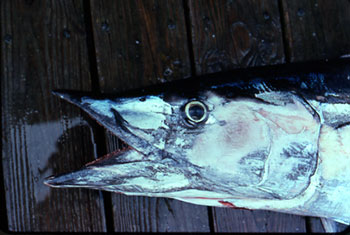
Distinctive Features
The wahoo is a slender, oceanic fish with a body covered with scales. Jaws are elongated to form an almost beak-like snout; the teeth are triangular and finely serrated. Two dorsal fins are present; the first is several times the length of the second. These fins are followed by 8 or 9 finlets. The anal fin is approximately below the second dorsal fin and is also succeeded by 9 finlets. The pelvic fins are situated below the pectoral fins. The caudal peduncle is narrow and contains three sets of keels.
Small scales cover the body and no anterior corselet is present. Lateral line runs the length of the body, abruptly curving under the first dorsal fin. A swim bladder is present.
Coloration
The body is dark blue or green above, with 24 or more wavy cobalt blue bars running vertically along the sides. The belly and lower sides are silvery.
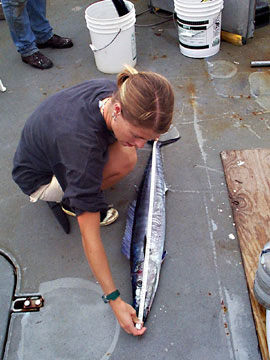
Size, Age, and Growth
The maximum reported size for the wahoo is 98 in. (250.0 cm) total length, with a maximum weight of 182 lb. (83 kg). Typically, individuals attain a size of 39 to 66 in. (100 to 170 cm). After reaching a length of 38-41 in. (96-105 cm), individuals grow at a rate of 1.2-1.5 inches (3-4 cm) per month. Latitude appears to influence size, with average weight increasing with distance from the equator, apparently correlated to cooler temperatures.
According to the International Game Fish Association (IGFA), the all-tackle record is 158 lb 8 oz (11.34 kg). Wahoo reach maturity between 1 and 2 years of age, depending upon location and sex. It is believed that wahoo live up to or more than 5-6 years of age.
Food Habits
Although wahoo are attracted to floating debris, their diet suggests they venture out to forage in open waters. Wahoo feed primarily upon other pelagic fishes, as well as squid. They have been recorded feeding on tunas, little tunny, porcupinefishes, flyingfishes, dolphinfish, jacks, herrings, pilchards, scads, and lanternfishes, as well as many other species.
Their fusiform body and great endurance allow them to pursue and overcome prey, which can be readily captured with their strong jaws. Wahoo have been recorded swimming at speeds of up to 75 km per hour in short bursts, allowing quick capture of prey species.
Reproduction
Spawning appears to occur over an extended period of time, at sites in the Caribbean Sea and near Florida. The simultaneous presence of wahoo at varying stages of maturity may indicate year-round spawning in some areas. In the western central Atlantic, wahoo spawn from May through August with peaks in activity during June and July. An average female may produce 60 million buoyant eggs per spawning. The size of wahoo at hatching is 2.5 mm. Little is known of the early life history of wahoo, however it is known that wahoo larvae are pelagic and prefer shallow water less than 330 ft. (100 m) in depth.
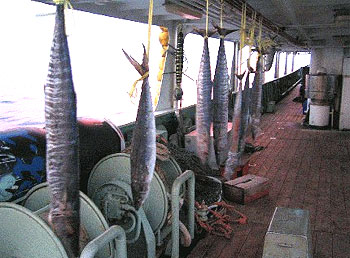
Predators
Sharks, including the silvertip shark (Carcharhinus albimarginatus) and other large predatory fish feed on the wahoo.
Parasites
Eighteen species of parasites have been reported from the wahoo. These include the copepods Caligus coryphaenae and Caligus productus which occur on the body surface as well as on the wall of the branchial cavities, and Brachiella thynni which is found on the fins. A digenetic trematode Hirudinella ventricosa also infects wahoo in the western Atlantic and Gulf of Mexico regions. Other parasites include udonellidea (copepod worms), digenea (flukes), didymozoidea (tissue flakes), monogenea (gillworms), cestoda (tapeworms), and copepods. Fish including the cookiecutter shark (Isistius brasiliensis) and the pilotfish (Naucrates ductor) are ectoparasites of the wahoo.
Taxonomy
The wahoo was first described by Cuvier in 1831, who named it Cybium solandri. It was changed toAcanthocybium solandri by Cuvier later that same year. The genus name is derived from the Greek words “akantha = thorn” and “kybion” “-ou” = a tunna. Other names used to refer to this fish have included Cybium saraLay and Bennet 1839, Cybium petus Poey 1860, Acanthocybium petus Poey 1860, Cybium verany Doderlein 1871, and Acanthocybium forbesi Seale 1912. A common misspelling occurring in recent literature isAcanthocybium solanderi.
Prepared by: Susie Gardieff